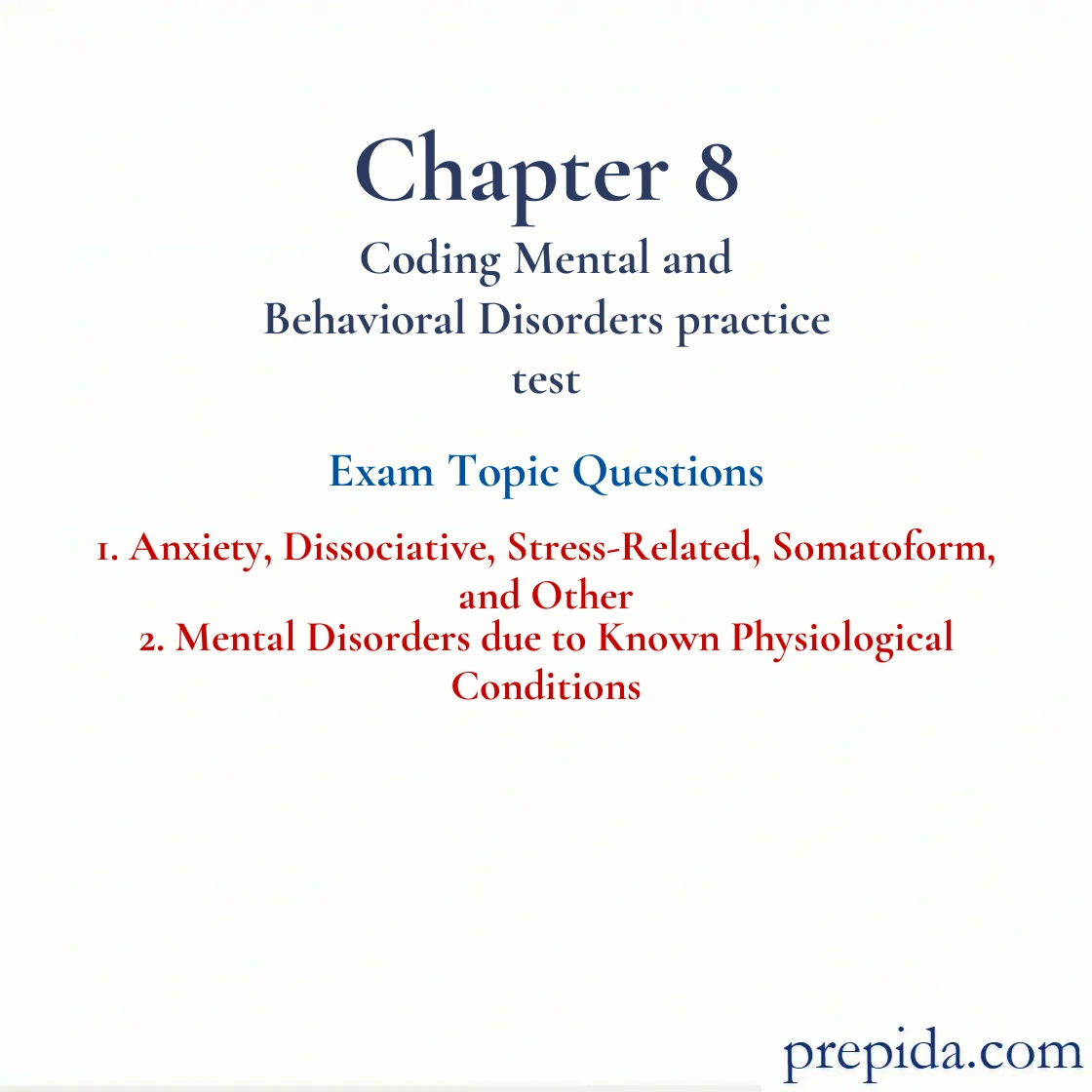
What is the correct code assigned for a patient with antisocial personality disorder?
- F60.0
- F60.1
- F60.2
- F60.3
The correct code for antisocial personality disorder is F60.2. F60.2: Index>disorder>personality>antisocial.
Sign: Objective evidence of a disease or condition.
What are the correct codes assigned for a patient with night terrors and hair plucking?
- F51.3, F63.3
- F51.4, F63.3
- F51.5, F63.3
- F51.6, F63.3
The correct codes for a patient with night terrors and hair plucking are F51.4 and F63.3. F51.4: Index>terror>night. F63.3: Index>hair>plucking.
Sign: Objective evidence of a disease or condition.
What is the correct code assigned for a patient with hypochondriasis?
- F45.20
- F45.21
- F45.22
- F45.29
The correct code for a patient with hypochondriasis is F45.21. F45.21: Index>hypochondriasis.
Sign: Objective evidence of a disease or condition.
What is the correct code assigned for a patient with a fear of women?
- F40.290
- F40.291
- F40.298
- F40.8
The correct code for a patient with a fear of women is F40.291. F40.291: Index>phobia>specific>women.
What is/are the correct code(s) assigned for a patient with a fear of blood, fear of injections, and fear of injury?
- F40.230, F40.231, F40.233
- F40.231, F40.233
- F40.232
- F40.230, F40.232, F40.233
The correct codes for a patient with a fear of blood, fear of injections, and fear of injury are F40.230, F40.231, and F40.233. F40.230: Index>phobia>specific>blood. F40.231: Index>phobia>specific>injections. F40.233: Index>phobia>specific>injury.
What is the correct code assigned for a patient with claustrophobia?
- F40.240
- F40.241
- F40.242
- F40.243
The correct code for a patient with claustrophobia is F40.240. F40.240: Index>claustrophobia.
Which of the following is not a mood disorder?
- Depression
- Apathy
- Euphoria
- Insomnia
Insomnia is not a mood disorder.
Which of the following is not a psychotic symptom?
- Depression
- Delusions
- Hallucinations
- None of these
Depression is a mood disorder, not a psychotic symptom.
Symptom: A subjective sensation or departure from the norm as related by the patient.
What is the correct code for a mood disorder due to a known physiological condition with depressive features?
- F06.30
- F06.31
- F06.32
- F06.33
The correct code for a mood disorder due to a known physiological condition with depressive features is F06.31. F06.31: Index>disorder>mood>due to>physiological condition>with>depressive features.
Condition: A health-related situation.
What is the correct code for vascular dementia without behavioral disturbance?
- F01.50
- F01.51
- F02.80
- F02.81
The correct code for vascular dementia without behavioral disturbance is F01.50. F01.50: Index>dementia>vascular.
Diagnosis: A physician’s determination of a patient’s condition, illness, or injury.
What is the correct code for senile dementia?
- F03.9
- F03.90
- F03.91
- F02.81
The correct code for senile dementia is F03.90. F03.90: Index>dementia>senile.
Diagnosis: A physician’s determination of a patient’s condition, illness, or injury.
An Excludes 1 notation tells the coder that:
- the excluded code can never be used at the same time as the current code because the two conditions cannot occur together in one patient at one time.
- the code in the exclude note is to be coded in addition to the code with the exclude note notation.
- the code in the exclude note and the code in the exclude note notation are both coded with the exclude note code listed as the principal diagnosis.
- None of these
The excluded code can never be used at the same time as the code the exclude notation is by as the two conditions cannot occur together.
Condition: A health-related situation.
Nerve cells are also known as:
- neurotransmitters.
- chemicals.
- neurons.
- synapses.
Nerve cells are also known as neurons.
Necrosis: The death of the tissue.
Nerve cells communicate with each other aided by:
- neurotransmitters.
- chemicals.
- neurons.
- synapses.
Nerve cells communicate with each other through neurotransmitters.